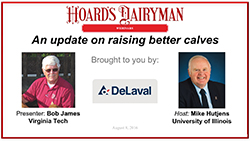
Raising healthy, well-grown calves is more than putting milk in a pail and dropping grain in a bucket. A newborn's chance for success starts as soon as it hits the ground. Colostrum sets the wheels in motion. How much was fed, how soon after birth was it fed, how high was the quality, and how clean was the equipment? They all matter.
Well-known calf expert, Bob James, presented the August webinar, "An update on raising better calves." Bob recently retired from Virginia Tech after 35 years in teaching, research and extension. He shared practical experience and scientific research.
Once you've provided a solid base of colostrum, the calf will consume milk or milk replacer for approximately the next eight weeks. Are you feeding the calf just enough to cover her maintenance needs, or is she getting more than adequate nutrition for growth and immunity?
When you look at your feeding protocols, how many of them are designed for the calf and how many for the person feeding the calves? This applies to the method of milk delivery - bucket or bottle, housing - hutches or group pens, feed delivery - automatic feeding or traditional, and number of feedings per day.
Some calf feeders mistakenly believe limiting liquid intake will encourage calves to eat starter and hay sooner. But, unfortunately, you are shorting the calf of nutrition on the milk side and calves do not eat enough more dry feed to replace the lost nutrition. Calves are loosing out on weight gain as heifers that translates to lost milk production as cows simply due to restricted intake early in life.
A 110-pound calf at freezing temperatures needs 9.4 pounds of milk to just meet maintenance requirements. That leaves no extra nutrition for growth. Getting such a young calf to consume larger volumes, may involve an additional feeding.
Calves fed three times each day were taller and had greater feed efficiency compared to calves fed the same amount twice per day. When weaned, calves raised in pairs had a smoother transition, with less growth check. Additionally, calves reared in pairs also consumed more dry matter than those housed individually. And, early pairing (a week of age) showed even higher results.
So while new research and technology can help us raise better calves, we still need to consider the people side as they are the caregivers for the future herd. Each operation needs to find its balance so people and calves can thrive.
The webinar was sponsored by DeLaval (www.delaval-us.com) and can be viewed here. All past webinars can be seen at www.hoards.com/webinars.

The author is the online media manager and is responsible for the website, webinars and social media. A graduate of Modesto Junior College and Fresno State, she was raised on a California dairy and frequently blogs on youth programs and consumer issues.








